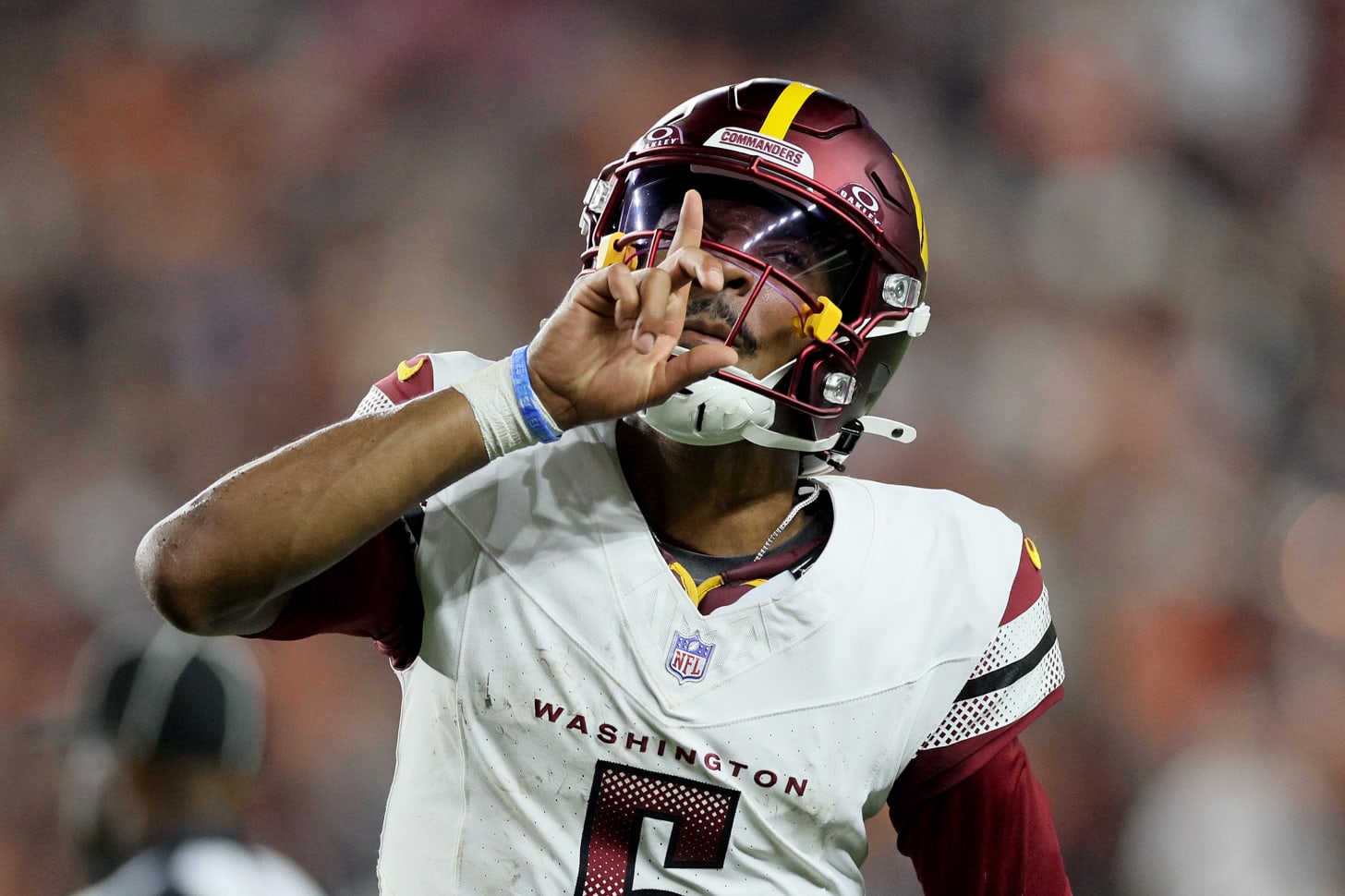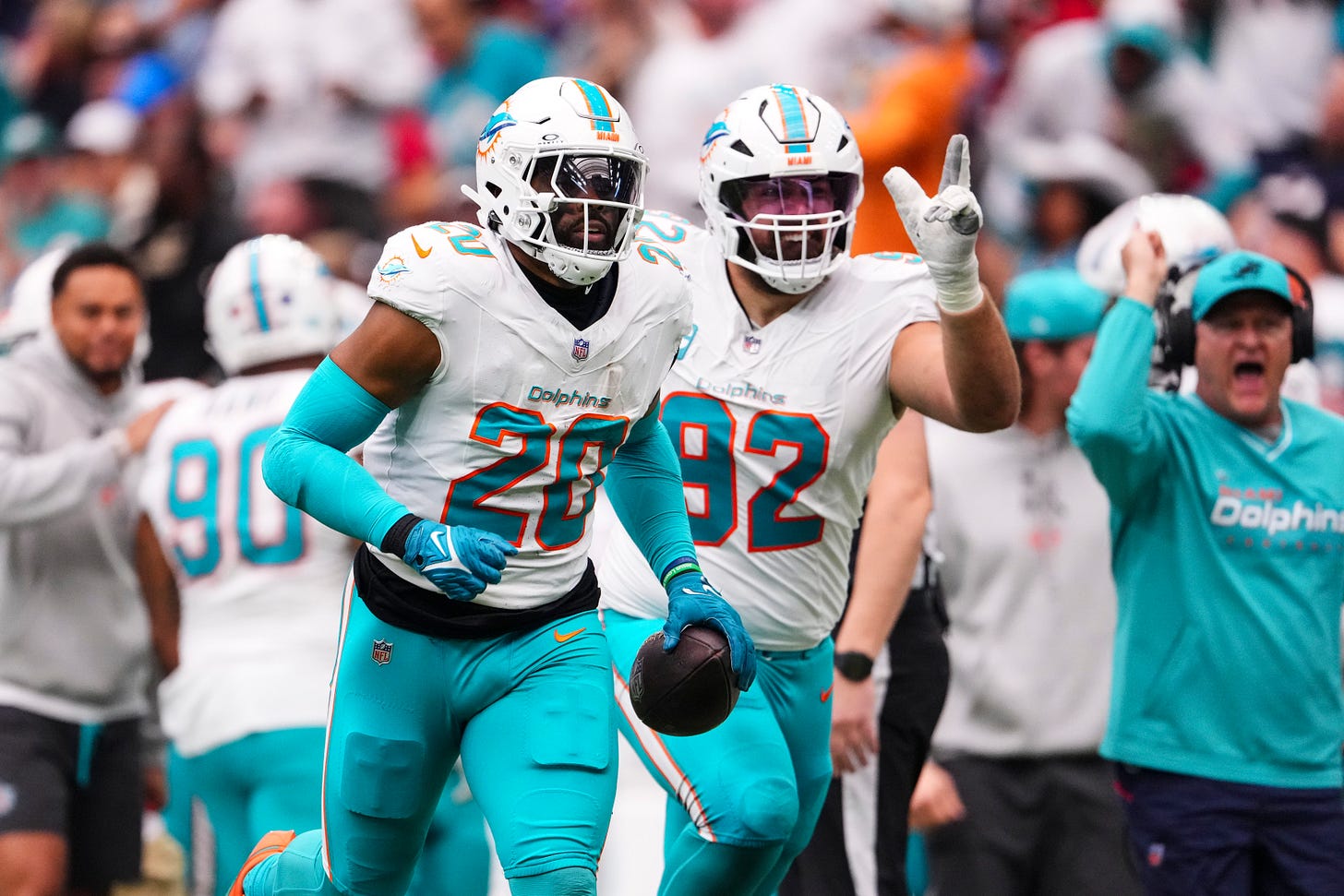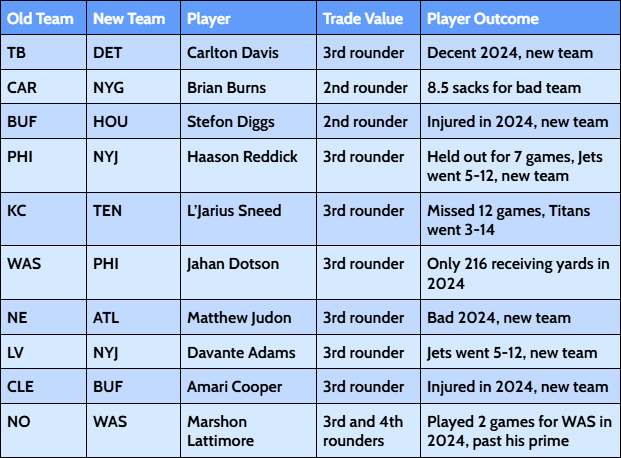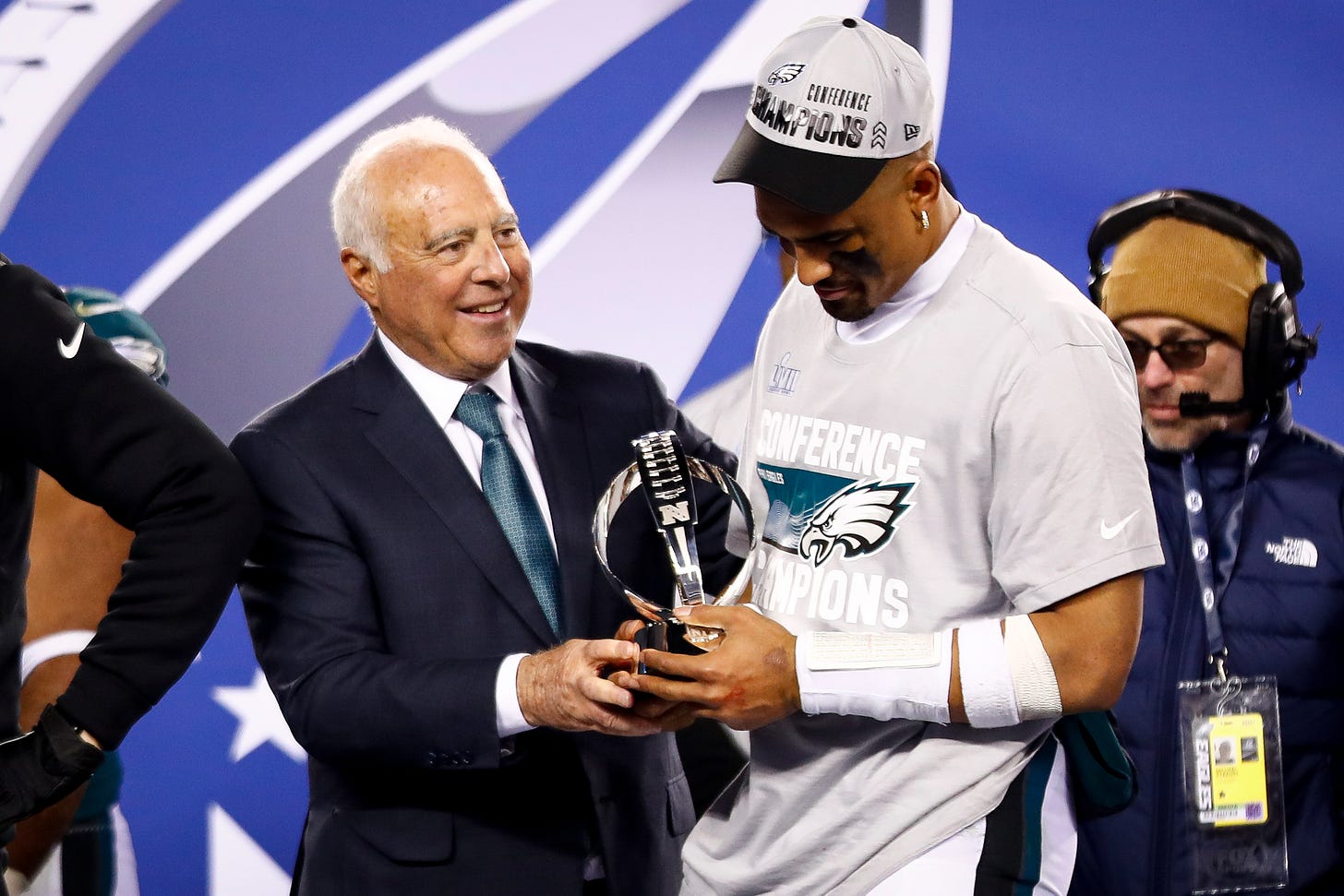What did we learn from the 2024 NFL Season?
This article examines key takeaways from the 2024 NFL Season as we approach Week 1 of 2025.
With the NFL kicking off today, I wanted to look back. The 2024 NFL season in many ways saw the sport walk back on how the league was trending in both schematic and personnel evaluation. We saw super-senior quarterbacks like Jayden Daniels light up the league in their rookie year, and running backs like Saquon Barkley and Derrick Henry singlehandedly revive the RB’s positional value across the NFL. These are just two examples of how 2024 challenges both my and many others’ conventional wisdom regarding the direction that football is going in, and I want to evaluate how strongly I should react to 2024.
With that said, here are my 12 biggest takeaways from the 2024 NFL Season:
#1 - Running Backs are valuable again… depending on one condition.
In 2017, the draft had so many RB prospects that drafting one highly almost seemed silly. Yes, Leonard Fournette and Christian McCaffrey were elite prospects, but you could get players like Aaron Jones and Alvin Kamara several rounds later, who provided 90% of the value at 10% of the cost. In the years following the 2017 draft, the theory that RBs were very easily replaceable made sense and was adopted by more analytical NFL fans.
But the depth at this position has eroded over time, and running the ball has been more important than ever. The difference between the top running backs and their backups isn’t as small as it was five years ago, where teams would be paying players like Ezekiel Elliott elite money even though Tony Pollard, his backup, was arguably more explosive.
Saquon Barkley is obviously the biggest example of this trend, as he was a transformative piece in the Eagles’ recent Super Bowl win. However, just because the Giants let him go doesn’t mean that they made a mistake. They actually did replace Saquon with a committee led by rookie Tyrone Tracy, getting more bang for their buck than they could have gotten from re-signing Barkley.
I’d argue that the Giants might’ve made the right call letting Barkley go, because I believe that Running Backs are worth investing in if you have a good offensive infrastructure and are at least a playoff team.
This condition makes sense at a granular level for both teambuilding and on-field impact. For teambuilding, RBs typically have short careers relative to other positions, so if you aren’t competing, there isn’t a great reason to hold on to a RB who almost certainly will be gone by the time your team is ready to make a run to the Super Bowl. On the field, bad offensive systems will likely constrain the RB to the first level of the defense. There isn’t a massive difference between superstars and replacement level players within the first few yards, as the results there largely depend on if blockers succeeded at their assignments. However, offenses that can more consistently give their RBs enough ground to get going can maximize the best runners in the sport by more consistently setting them up for the possibility of a breakaway run.
Saquon Barkley wasn’t especially helpful on the Giants, but with Eagles blocking, he had more opportunities to use his talent. The same goes for Christian McCaffrey, who was far more useful to the 49ers than he was to the Panthers. Overall, I don’t see Saquon’s breakout season as a total end to the “RBs don’t matter” movement, but it’s clear that the pendulum had swung too far that way.
#2 - Don’t let a Quarterback’s age deter you from drafting them.
This lesson definitely applies to myself, as I wasn’t a huge fan of Jayden Daniels and Bo Nix as prospects. I took the stance “of course they’re dominant in College, they’re way older than anybody else there,” without contextualizing why they took as long as they did to break out, and refusing to consider other explanations for their improvements.
Daniels had some clear flaws in his game, but during the 2023 LSU season, he transformed his play. His processing and mental sharpness shined, and I was a fool to think that he couldn’t make that kind of progress in 2023 again in 2024. One tool he used was Virtual Reality, functionally allowing him to simulate games and get good reps in. In his 2024 season, first in the NFL, he transformed his scrambling tendencies, becoming a QB who was a threat to throw outside of the pocket, rather than the LSU version of Jayden Daniels who only scrambled to run.
Although on the surface, it seems like this playstyle change was impossible to predict, the strides he made mentally in 2023 should’ve shown myself and other evaluators that he is improving at a really fast rate. The reps in college helped him be more comfortable reading defenses in the NFL, and playing against lower-level competition when he had already turned 23 probably helped him develop in the long-run. With Daniels’s success and Anthony Richardson’s failure, evaluators like myself need to reconsider if QBs with tons of college seasons under their belt are a red flag or a green flag.
Picture of Jayden Daniels, image credit to the Washington Post.
#3 - Teams should extend their young talent as soon as they can.
This one is probably obvious, yet the Cowboys fall victim to waiting out extensions until the last possible minute. With Dak Prescott and Ceedee Lamb, they had opportunities to sign them in March of their given extension seasons, but Jerry Jones opted not to.
If an owner is unsure if a talent is worth retaining, I understand waiting, but Lamb and Prescott were anything but that. Ceedee Lamb could’ve easily been signed for $36.9 million annually before the Vikings signed Justin Jefferson to that figure, but once Jefferson was under contract, Lamb wanted to out-earn Jefferson, and he wasn’t going to take any less than the $38 million AAV they settled on.
The process of extending players as soon as you know you want them long-term works so well because the salary cap increases every year. If you’re paying a player 15% of the salary cap in 2024, that same salary may shrink to close to 10% of the salary cap in 2027, making the deal easily worth it. It’s basic economics, buy your players when they won’t be any cheaper, and reap the benefits.
No organization reaped the benefits than the loaded Philadelphia Eagles, who extend everyone early. They extended Devonta Smith, Saquon Barkley, AJ Brown, and Jalen Hurts as soon as they could, and are underpaying the newly established markets for similar players because they did their contracts first. Owners like Jerry Jones who are unwilling to admit that extending players early is optimal will likely see their teams fall short due to them taking on such a rough competitive disadvantage.
#4 - Don’t give rookie QBs to hot-seat regimes.
This one is probably obvious, yet the Chicago Bears fall for it every few years. Young quarterbacks often need to be put on timelines that prioritize their long-term development, so allowing a GM or Head Coach to make decisions on his future because they are worried about saving their jobs is malpractice. The Bears have amazingly done this with their last three quarterbacks. Firing the coaching staffs of Mitchell Trubisky’s, Justin Fields’s, and Caleb Williams’s rookie seasons.
Developing a quarterback is a difficult task, and even teams who take all of the right steps can still fail at nurturing good passers. I think back to a recent Kevin O’Connell (Vikings HC) quote, stating "I just think, as a whole, there's not enough emphasis put on the organization's role in the development of the (QB) position. I believe organizations fail young QBs before young QBs fail organizations.” O’Connell, a failed NFL QB turned successful NFL Head Coach, agrees with the trends and data that indicate that the QB, HC, and GM need to all be on the same timeline.
This also applies to Anthony Richardson, whom the Colts let Chris Ballard select, despite Ballard being a very untrustworthy GM at the time (who I thought should have been fired). The first two years of Richardson’s career have shown me that Ballard needs to be replaced, but because Richardson is around, the Colts had to hold on to a bad GM because any other GM would ditch the young QB and get their own passer. I just hope that the Giants don’t ruin Jaxson Dart’s development by making a desperation move, and that he’s given a real chance with Brian Daboll. If not, I fear the Giants will be making the same mistakes that have haunted Chicago in their recent past.
Photo of Caleb Williams (Left) and Matt Eberflus (Right), image credit to Chicago Sun-Times.
#5 - If your TE cannot block, he is no more than a mediocre slot receiver.
With the emergence of Nickel defense (5 defensive backs, as opposed to base defense with 4 DBs), defenses consistently play at least five DBs whenever the offense uses three WRs. A common way to get a team out of Nickel is to substitute one of three WRs for a second TE, as many defenses respond to that substitution by taking off a DB for a linebacker.
However, there exists some TEs who aren’t good enough blockers to justify the opposing defense needing to add a linebacker. Take Buffalo’s Dalton Kincaid, for example. He’s an exceptional receiver for a TE, but if teams treat him like they would a WR and keep 5 DBs on the field, he should be evaluated largely against other WRs.
Slot Wide Receivers have also become much better blockers. They aren’t fitting the stereotype as often as they have. As opposed to players like Julian Edelman, who are extremely small but have incredible short-area burst and quickness, many modern slot receivers are bigger players like Cooper Kupp.
This trend got popular in the late 2010s, as playcallers such as Kyle Shanahan and Sean McVay would design entire offenses around Outside Zone, a run concept that fundamentally aims to get fast RBs in space 1-on-1 against smaller defenders such as defensive backs. Obviously, you can’t get to the perimeter without working through where a slot receiver would be, so these schemes would prioritize slot WRs who could block more than other offenses because the pillar of their run attacks were built on having a WR who could block defensive backs pursuing tackles.
The rise of Nickel defense and blocking-proficient slot WRs have made receiving-only TEs almost a relic of the past, almost stuck in between being good enough blockers to be a good TE and good enough receivers to be a WR. This is why if a TE can’t block, he unfortunately needs to be compared to WRs, as that's how defenses treat them.
#6 - Let other teams evaluate Linebackers for you.
The emergence of play-action in the late 2010s, where teams would fake a handoff in hopes of luring linebackers away from zones in the middle of the field to throw to, put linebackers in conflict so often and demanded them to basically guess if a handoff was a play-action fake or a real running play.
Since then, drafting linebackers in the first few rounds has largely not worked out. Even the players who panned out, like Baltimore’s Roquan Smith and Miami’s Jordyn Brooks, took so long to learn the position that they’ve had their best years on their second teams. This long development curve exists because of how different the position is in College vs the NFL, and it makes drafting LBs highly an endeavor that almost never returns value.
Plenty of teams have found tons of success chasing second-contract LBs, more than just Smith and Brooks. The Giants signed Bobby Okereke, the Raiders with Robert Spillane, Vikings with Blake Cashman, Texans with Azeez Al-Shaiir, Packers with De’Vondre Campbell, and many more.
This isn’t to say that early-drafted LBs will always fail, that’s not the case, and I actually really like Jihaad Campbell, the lone first-round LB in the 2025 draft. And just because it may be smart to avoid taking early-round LBs, that doesn’t make ignoring the position like the Rams have a good strategy either. However, spending such a valuable resource on a (relatively speaking) low-success rate position is very often a worse strategy than signing players with a few years of experience who are often more productive on the field.
Picture of Jordyn Brooks, image credit to Action News Jax.
#7 - Any viable NFL defense needs to disguise some of its coverages.
Disguising coverages used to be a niche thing that few NFL teams did even as recently as three years ago. In 2024, the five NFL teams hired from a coaching tree that emphasized disguised coverages in a way that dominated 2023, and will likely change the NFL for years to come.
Everyone wants to replicate the 2023 Ravens defense. Why wouldn’t they? After all, Baltimore had debatably the best defense in the NFL last season and did so without a dominant defensive line, which is an anomaly in top defenses. 2023 Ravens Defensive Coordinator and now-Seahawks Head Coach Mike Macdonald brought his scheme from Michigan to the NFL, one that thrived on disguised coverages.
Many previous trendy defenses have been built on trade-offs, such as the early 2020s Vic Fangio-influenced schemes that prevented explosive plays in exchange for being weaker against opposing run plays. Rather than present a new coverage, new formations, or new shells, the act of disguising whatever they’re running by lining up in a formation typically presented in another type of coverage. Most commonly, teams disguise the “shell” of their defense, that being basically whether or not they are playing with an even number (often two) of safeties deep, leaving the middle of the field open (MOFO) versus playing with an odd number of safeties deep, thus putting one directly in the middle of the field and closing it off (MOFC).
This system presents space in defense pre-snap and then takes it away post-snap, forcing opposing quarterbacks to diagnose the coverage in the (literally) two seconds they have before the opposing pass rush collapses the pocket.
Disguising coverages seem like they have no drawbacks on the surface, but they are harder to implement and teach to younger players, making it a risky proposition for defensive coordinators. Lou Anaroumo’s Bengals are the best example of this risk, as his 2021 defense that stumped Patrick Mahomes with tons of disguised coverages en route to a Super Bowl appearance with tons of veteran players like Vonn Bell and Chidobe Awuzie. However, Cincinnati’s defense was among the worst in the NFL in 2024, in large part due to his scheme being much harder for the much younger Bengals roster to execute how he wanted it.
Disguised coverages are still largely a very effective strategy, and teams like Gus Bradley’s Colts, who never use them, often get diced up by good playcallers and Quarterbacks due to their predictability. One evolution I’m interested in with disguised coverages this season is evaluating if QB scrambles are more effective against disguised coverages due to less players being able to always keep their eyes on the QB because they’re shifting their responsibilities/zones on the second and third levels. Though it’s not a beats-all solution to defense, disguised coverages are a necessary component to a good defense in 2025.
#8 - If you make an aggressive trade, you better be a contender.
Truthfully, the team that gains a draft pick gets the better end of a trade far more frequently than the casual fan would expect. Take, for example, the Matthew Judon trade. The Patriots got the Falcons’ 3rd round pick for Judon, as Atlanta desperately wanted a good pass rusher while New England was clearly years away from competing.
The Judon example is among the worst, but rarely ever is it worth it for teams to trade draft picks in the first few rounds for a player past their prime. Here is a list of every player traded for a third round pick or better in 2024, and how the trade fared for the team trading away a pick.
As you can see, every single trade has gone poorly for the team trading away a draft pick. They had to pay salary, give away a draft pick (which are extremely valuable in the NFL), and many of the traded players have already switched teams. The one recent example of an aggressive non-QB trade like this one working out for the team trading away a pick was the Rams’ trade for Von Miller, as he was a key piece in their 2021 Super Bowl win.
The one trade where you could argue the value was appropriate was Brian Burns, and while I somewhat agree, the issue with that trade is that the Giants are years away from being competitive, so the second-rounder may be more valuable for them specifically.
Now, I have to clarify that the recent Micah Parsons trade is different, as although I still think the Packers gave up a lot, they did so for a player who is nearly guaranteed to be one of the five best defenders in the NFL for the rest of this decade. The trade was a slight underpay, but not a drastic one, and I think it’s far worse for Dallas than it is good for Green Bay. Players like Parsons, who is one of ten best players in the NFL and only 26 years old, are worth giving up huge draft pick hauls for.
In most of these cases, however, you need a 90th percentile outcome for a trade to return value, and you need to be competitive right away for it to make sense long-term. So, next time you see an old player like Deebo Samuel or Marshon Lattimore be traded for a mid-round draft pick, don’t panic that your team didn’t make that trade, as odds are they’re dodging a bullet.
#9 - Guards and Defensive Tackles are becoming premium positions
For a while, Left Tackles and Edge Rushers were the only linemen who would even get close to being the highest-paid non-QB. As teams play more nickel defense, they’re committing less players to stopping the run, meaning that each player is more important in run defense than they have been before. That’s where Defensive Tackles come in, being the anchor of run defense.
Nose Tackles are often under-appreciated because they don’t stuff the box score, but their absence is seen when they aren’t on the field. Take the Bengals, whose run defense cratered once DJ Reader left for the Lions. The Colts also saw a massive dropoff when Grover Stewart got suspended in October of 2023, going from allowing just one of their first 6 opponents to each 100 RB rushing yards to all 6 opponents reaching that mark during his suspension. Their appearances aren’t flashy, but good interior defensive linemen can keep opposing running games in check.
Offensive Guards also fit into this equation, but they benefit from an entirely different set of trends, one among many being the increase in running Quarterbacks. With many QBs able to take advantage of clean pockets and stepping up in the pocket to get high-value scrambles, the success of an offense’s interior is highlighted more in today’s game than it has been before. Again, there are tons of reasons why Guards are getting paid more relative to other positions than they have been previously, but this is one example I’ve noticed lately.
#10 - Cash Spending Determines Margin for Error
While the NFL is technically the only big-4 American sports league with a proper salary cap, the mechanics of the cap still give advantages to teams with cash-rich owners. This is due to restructuring and signing bonuses, essentially allowing owners to pay more money up front in signing bonuses, and in exchange for being more flexible with cash short-term, they spread out the cap hit of said signing bonus throughout the duration of a contract (and sometimes longer).
This allows teams that are trying to win a Super Bowl to be very aggressive. For example, if a contender had <$5M left in cap space, but wanted to sign a player to a $8M contract for one year, they could. They’d use void years, and essentially have the player be a $2-3M dead cap hit for the second and third years when they will be on a different team, in order to keep the year 1 cap hit to around $4M.
Owners like Philadelphia’s Jeffery Lurie are constantly able to go all-in on winning cores, backloading the contracts of star players such as Jalen Hurts and AJ Brown. Both Hurts and Brown, as well as most of the Eagles, are making much lower than their annual average early on in their contracts, and they’ll often re-extend with the team whenever they reach their more expensive years with the team.
Jalen Hurts is the most egregious example, as he’s only counting for $22M against the cap in 2025 (up from a puny $14M in 2024), when he’ll be making more than double that figure in just 2 years, and he also has a ton of void years where Hurts counts against $30-40M of the cap but isn’t on the team, essentially pushing his cap hits into the future. So, while the NFL does have a salary cap, there is still a massive pay-to-win element of salary management, one that becomes even more relevant as teams structure contracts as aggressively as ever
Picture of Jeffery Lurie (Left) and Jalen Hurts (Right), image credit to Bleeding Green Nation.
#11 - Free Agency is Won by Teams who Chase Miscast Players
Like the Draft, NFL Free Agency is a crapshoot. Players like Zack Baun will be signed to minimum contracts and become all-pros, while teams like the Raiders will pay Christian Wilkins a market-correcting deal and release him just one season later. In general, what we don’t realize is that for every Zack Baun, there’s tons of failed experiments, but it’s still worth the very low-risk gamble of getting an impact starter. Signing players who didn’t pan out with their first teams, like Baun or Sam Darnold, is like a nearly free lottery ticket.
To make the math behind this theory even simpler, let’s say that Patrick Queen cost the Steelers $15M per year. It may be smarter to instead spend that money on several players, functionally just to have more bites at the apple. Now, I’m not saying to never spend on good players, but teams should aim every year to try a few reclamation projects, because their cost is nearly nothing while their reward could be a Lombardi Trophy.
#12 - My Weak Link Article still Applies
If you enjoyed this article, read my article on optimal roster construction when it comes to premium positions such as Wide Receiver and Edge Rusher versus Offensive Tackle and Cornerback.







